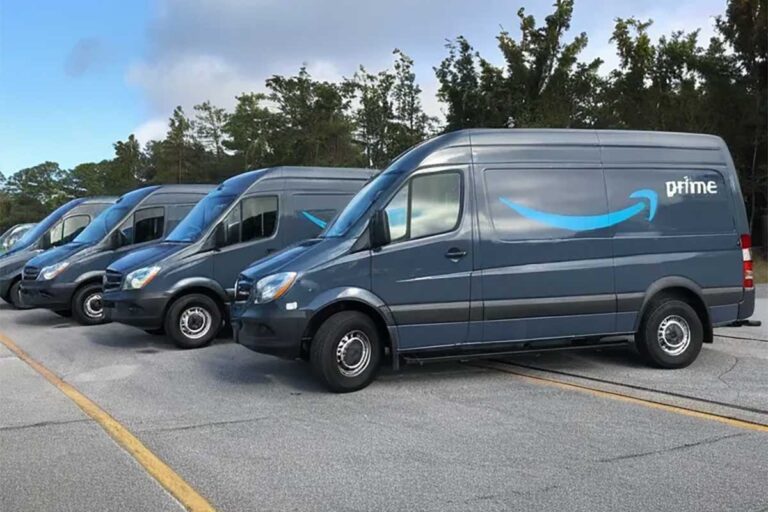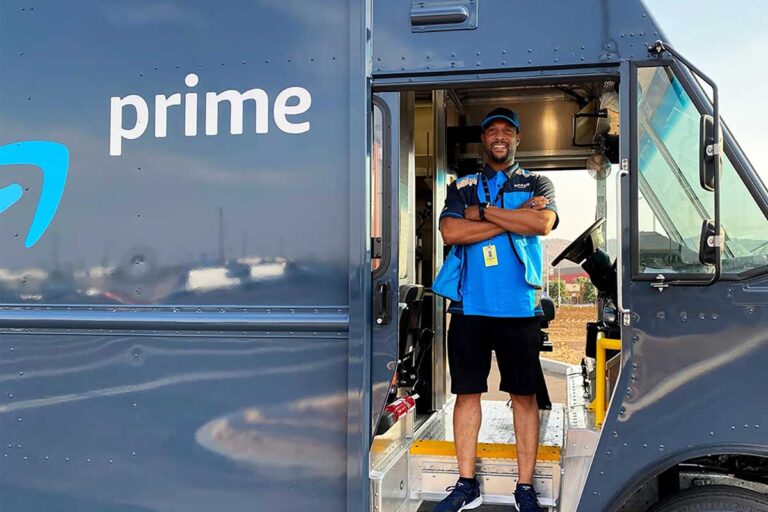The Safety Violation Crisis in Amazon Trucking Contractors
Amazon facilitates the delivery of billions of packages across the United States annually. The company employs contractors to manage a substantial number of these deliveries, utilizing services such as Amazon Relay for middle-mile logistics and programs like Amazon Flex and Delivery Service Partner (DSP) for last-mile operations. These contractors play a crucial role in Amazon’s expansive delivery network. However, this efficiency and scale have come at a cost. Studies and investigations have consistently shown that Amazon’s trucking contractors have higher rates of safety violations than other carriers. These violations include speeding, texting while driving, and other unsafe practices, raising serious concerns about public safetsy, corporate responsibility, and regulatory oversight. This report delves into the alarming trends of safety violations among Amazon’s trucking contractors, examines the underlying causes, and discusses the broader implications for road safety and corporate accountability.
A Preventable Tragedy
CBS News conducted a comprehensive analysis prompted by a tragic incident involving a young college student. On January 3, 2022, a tragic accident on a Texas highway claimed the life of 19-year-old Iliana Velez, who was struck by a box truck driven by Jordan Sannicola, an employee of the contractor Take Flight with B. Witnesses reported that Sannicola’s reckless driving forced Velez’s vehicle off the road, resulting in a fatal rollover crash.
Authorities apprehended Sannicola weeks later after he fled the scene, revealing a suspended driver’s license and outstanding felony warrants. He was using a mobile device during the incident. Alarmingly, despite Amazon denying him a position in their home delivery service due to his questionable driving history, he secured a driving role with another contractor.
Alarming Rates of Safety Violations
Multiple investigations have highlighted that Amazon’s trucking contractors exhibit a much higher rate of safety violations compared to other carriers. A six-year analysis by CBS News of Federal Motor Carrier Safety Administration (FMCSA) data revealed that Amazon contractors had unsafe driving rates at least 89% higher than non-Amazon carriers every month. The violations primarily involved speeding, texting while driving, and other reckless behaviors. In many months, the unsafe driving incidence among Amazon’s contractors was more than double that of other delivery services.
Fatalities and Accidents Involving Amazon Trucking Contractors
The consequences of these safety violations have been devastating. Since 2015, trucking contractors working for Amazon have been involved in at least 75 fatal crashes, according to reports. These incidents include:
- On August 16, 2022, a 2-year-old child was killed by an Amazon delivery van in Irvine, California. The driver, an 18-year-old working for a third-party contractor, was reportedly distracted by his phone and had packages obstructing his view.
- A 19-year-old college student killed in Texas in 2022 due to a crash caused by an Amazon-contracted driver.
- A 6-year-old girl and her grandmother struck by an Amazon delivery driver in New Jersey in December 2024. The driver ignored a school bus stop sign while using a cellphone.
- A 79-year-old pedestrian killed in November 2024 by an Amazon driver who fled the scene. The driver was later found to be in possession of narcotics.
These incidents are not isolated but part of a broader pattern of safety lapses within Amazon’s logistics network.
Injured by an Amazon Truck? Contact Us For A Free Consultation
Injured by an Amazon Truck?

Holding Amazon Accountable
In September 2024, a landmark verdict of $16.2 million was awarded against Amazon Logistics following a case where a delivery vehicle crash severely injured an eight-year-old boy. Amazon attempted to evade liability by asserting that the driver was an independent contractor. However, lawyers successfully argued that Amazon’s extensive control over its delivery partners warranted their accountability as an employer.
Accidents involving Amazon and similar companies that utilize contractors can often be legally intricate. If you or someone you love has been injured or killed in such incidents, obtaining experienced legal representation is essential for pursuing justice and accountability. At The Jewkes Firm, LLC, we specialize in trucking litigation. For a free consultation regarding your potential legal case, please reach out to us at (770) 771-5130.
Overview of Amazon’s Logistics Network
Amazon has revolutionized the way goods are delivered, establishing a complex and expansive logistics network that supports its vast e-commerce platform. The company blends in-house operations with partnerships with third-party contractors, particularly in the trucking sector. Understanding the structure and dynamics of Amazon’s logistics network is essential to grasp the implications of safety violations among its trucking contractors.
The Role of Trucking Contractors in Amazon’s Supply Chain
Trucking contractors play a crucial role in Amazon’s logistics framework, acting as the backbone of its transportation operations. These contractors are responsible for transporting goods from Amazon’s fulfillment centers to various delivery points, including distribution hubs, retail locations, and directly to consumers’ doorsteps. By utilizing independent trucking firms, Amazon can rapidly scale its delivery capabilities, ensuring that it meets the increasing demand for fast shipping options. This flexibility allows Amazon to maintain a competitive edge in the e-commerce market by providing customers with swift and reliable delivery services.
Growth of Amazon’s Delivery Services and Its Impact
The growth of Amazon’s delivery services has been monumental, particularly in the wake of the COVID-19 pandemic, which accelerated the shift towards online shopping. As the demand for quick delivery options surged, Amazon expanded its logistics operations, increasing its reliance on trucking contractors. The introduction of programs such as Amazon Flex, which allows individuals to deliver packages using their own vehicles, further exemplifies this growth. However, this rapid expansion has raised concerns regarding the sustainability of safety practices within these contracted entities, as the urgency to fulfill delivery promises often leads to increased pressure on drivers and operational teams.
Comparison with Other Delivery Companies
When compared to traditional logistics providers, Amazon’s approach to trucking and delivery is distinctive. While companies like UPS and FedEx have long-established operational frameworks with a focus on safety and compliance, Amazon’s model leans more heavily on a decentralized network of independent contractors. This difference in operational structure can result in varying standards of safety and compliance.
Amazon is not the only e-commerce company facing safety challenges, but its record stands out when compared to competitors:
- UPS. With a fleet of 120,000 vehicles, UPS reported 2,632 accidents and 56 fatalities between 2021 and 2023. UPS emphasizes driver training and vehicle maintenance to mitigate risks.
- FedEx. FedEx reported 360 crashes and 9 fatalities during the same period. While its accident-to-fleet ratio is better than UPS, it still struggles with delivery pressure.
- Amazon. Over a decade, 75 fatal crashes involved Amazon contractors. Drivers committed safety violations that were significantly higher than industry averages.
Many traditional providers have systematic training programs and rigorous safety protocols, whereas the flexibility of Amazon’s contractor model can lead to inconsistencies in adherence to safety regulations across its logistics network. As Amazon continues to expand and innovate, the implications of this contrast become increasingly significant, particularly in light of the rising safety violation rates among its trucking contractors.


GEORGIA PERSONAL INJURY LAWYER NEAR ME
Safety Violations Among Trucking Contractors
The rise of Amazon’s logistics network has brought with it an array of concerns, particularly regarding safety violations among its trucking contractors. As the demand for rapid delivery increases, the pressure on these contractors often leads to a troubling pattern of safety issues.
Types of Safety Violations Reported
Amazon trucking contractors are linked to a variety of safety violations. These include, but are not limited to, speeding, driving under the influence of drugs or alcohol, failing to maintain proper vehicle inspections, and violating hours-of-service regulations. Each of these violations not only endangers the drivers themselves but also poses a significant risk to other road users. The nature of these violations often stems from the intense pressure to meet Amazon’s stringent delivery timelines, which can lead to compromised safety standards.
Statistics on Violations Compared to Industry Standards
Recent studies indicate that the rate of safety violations among Amazon’s trucking contractors is notably higher than the industry average. According to data compiled from various regulatory agencies, the violation rate for contractors affiliated with Amazon is approximately 30% higher than that of traditional trucking companies. This alarming statistic highlights the potential for a systemic issue within Amazon’s logistics framework, where the emphasis on speed and efficiency may overshadow essential safety practices.
In summary, the prevalence of safety violations among trucking contractors associated with Amazon is a growing concern that necessitates a closer examination of the practices, pressures, and policies that contribute to these alarming statistics. As the company continues to expand its delivery services, addressing these issues will be vital for ensuring the safety of its drivers and the general public.
Factors Contributing to High Violation Rates
Several factors that place significant pressure on Amazon’s trucking contractors contribute to the rising rates of safety violations among them. Understanding these elements provides a clearer picture of the challenges faced within this segment of Amazon’s logistics network.
Decentralized Contractor Model
Amazon’s delivery network relies heavily on a vast patchwork of third-party contractors, including small and inexperienced trucking firms. Jason Miller, a supply chain management expert and professor at Michigan State University, pointed out that Amazon’s extensive network of diverse small contracting firms complicates efforts to maintain consistent safety standards. Numerous small firms make it challenging to monitor and ensure the safety practices of freight.
Pressure to Meet Delivery Deadlines
Amazon’s promise of fast delivery, including its two-day Prime shipping, places immense pressure on drivers to meet tight schedules. This urgency often leads to speeding, violations of hours-of-service regulations, and other unsafe practices.
Lack of Oversight and Accountability
Amazon relies on the FMCSA to oversee its contractors, but this regulatory framework has limitations. While Amazon claims to suspend contractors who violate safety guidelines, the sheer scale of its operations makes comprehensive oversight difficult. While Amazon claims to have stringent safety standards for its contractors, investigations suggest otherwise. For example:
- A driver working for an Amazon contractor had 70 speeding violations, yet Amazon took no action.
- Amazon contractors were found to have unsafe driving scores more than twice as high as similar companies.
Furthermore, Amazon often distances itself from liability by arguing that its contractors are independent entities, even in cases where negligence is evident.
Broader Implications
Amazon’s reliance on gig workers and its decentralized contractor model contribute to its higher violation rates, making it an outlier in terms of safety performance.
Public Safety Risks
The high rate of safety violations among Amazon contractors poses a significant threat to public safety. With millions of deliveries occurring daily, the likelihood of accidents increases, endangering drivers, pedestrians, and other road users.
Legal and Financial Consequences
Amazon has faced multiple lawsuits related to accidents involving its contractors. The court rejected the company’s attempts to deny responsibility.
Ethical and Reputational Concerns
Amazon’s failure to address safety issues undermines its corporate responsibility and tarnishes its reputation. Critics argue that the company prioritizes profits and efficiency over the well-being of its contractors, employees, and the public.
Need a Free Consultation? Need a Skilled Attorney?
Free Consultation
Call (770) 771-5130
If you’ve been injured, you need to hire the best legal care to assist you with your claim. Get a FREE consultation today!
Amazon’s Stance on Safety Compliance
Amazon has acknowledged the safety concerns and claims to have taken steps to address them. According to Tim Goodman, Amazon’s global legal director for road safety, the company relies on the FMCSA to oversee its middle-mile contractors. Additionally, Amazon states that:
- 96.5% of its trucking contractors now meet its internal safety standards, which are reportedly more stringent than federal Department of Transportation (DOT) requirements.
- The network suspends contractors who fail to meet safety standards.
Amazon maintains that contractors found violating FMCSA regulations face strict penalties, including potential permanent suspension from their services. Indeed, Take Flight with B was permanently suspended and has since ceased operations. However, critics argue that these measures are insufficient. The continued occurrence of fatal accidents and high violation rates suggests that Amazon’s oversight mechanisms remain inadequate. And, this response does not fully address the accountability Amazon holds regarding the actions of its contracted drivers.
Recommendations for Improvement
To address the safety concerns, Amazon must take the following steps:
- Centralized Oversight. Amazon should adopt a more centralized approach to contractor management, reducing reliance on small, independent firms and working with larger, more established carriers that can maintain higher safety standards.
- Enhanced Safety Training. Implement mandatory safety training programs for all contractors and drivers, focusing on reducing speeding, distracted driving, and other unsafe practices.
- Technology Integration. Amazon could leverage technology to monitor driver behavior in real-time, using telematics systems to track speeding, harsh braking, and other risky actions.
- Invest in Driver Training. Provide mandatory training programs for all contractors to promote safe driving practices.
- Stronger Accountability Measures. Amazon must take greater responsibility for the actions of its contractors. Establish clear penalties for contractors with repeated violations and ensure prompt action against unsafe drivers.
- Regulatory Collaboration. Amazon should work closely with the FMCSA and other regulatory bodies to ensure compliance with safety standards and improve oversight mechanisms.
The high rates of safety violations among Amazon’s trucking contractors highlight a critical issue within the company’s logistics network. While Amazon’s decentralized contractor model and emphasis on efficiency have enabled rapid growth, they have also created significant safety risks. Addressing these challenges requires a comprehensive approach that prioritizes public safety, enhances oversight, and holds contractors accountable. Failure to act could result in further accidents, lawsuits, and damage to Amazon’s reputation.




